Hosting Virtual Art Exhibitions: Earn Extra Cash from Home

Hosting virtual art exhibitions has opened up new possibilities for artists and curators alike. By turning your art exhibition into a virtual event, you can reach a global audience and showcase your work from anywhere in the world.
This makes it an ideal side hustle for anyone looking to expand their reach and create a new revenue stream, especially when hosting a virtual exhibition.
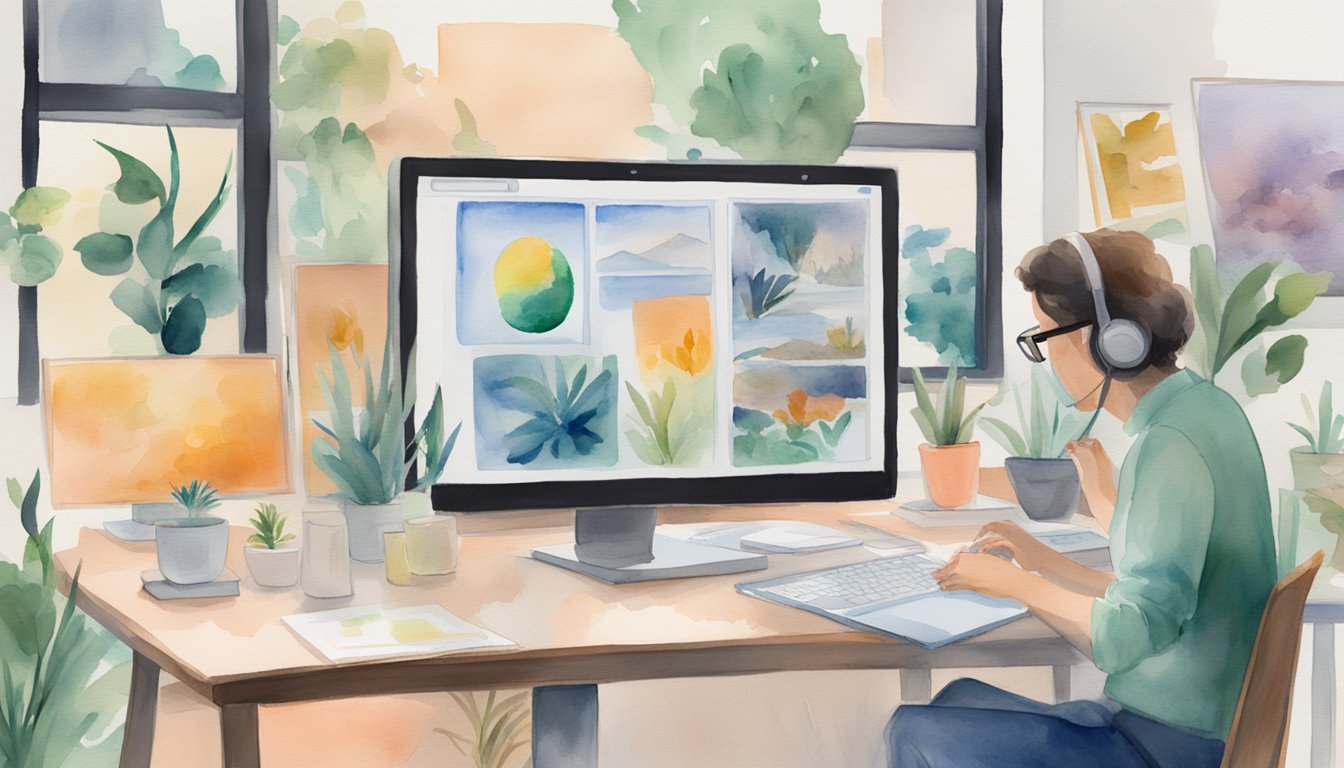
Choosing the right platform for your virtual art exhibition is crucial.
Platforms like Exhibbit and ArtPlacer offer customizable gallery spaces that can be tailored to match your style.
Using these tools, you can create immersive and engaging content that will captivate your audience.
Marketing your online gallery effectively is key to driving attendance.
Utilize social media, email newsletters, and partnerships to attract visitors.
Leverage analytics to understand your audience better and optimize your exhibition for both sales and lead generation.
Hosting virtual art exhibitions isn’t just about showing art—it’s about building your reputation and establishing a strong online presence.
Key Takeaways
- Virtual exhibitions reach a global audience and are great as a side hustle.
- Choose a customizable platform to create engaging and immersive content.
- Effective marketing and analytics are essential for success.
Choosing the Right Virtual Exhibition Platform
When starting a virtual art exhibition, picking the right platform is key to your event’s success.
You’ll need a tool with essential features and an easy-to-use interface to ensure everything runs smoothly.
Key Features to Look For
When you’re evaluating virtual exhibition platforms, there are some critical features to consider:
-
User-Friendly Interface: You want a platform that’s easy to navigate for both you and your guests. Complex systems can frustrate visitors and deter participation.
-
Customization Options: Look for platforms that allow you to personalize the virtual space to match your brand or theme. This could include adding logos, custom backgrounds, and specific layouts.
-
Interactive Tools: Features like chat, Q&A, and networking areas can make your exhibition more engaging. These tools enable visitors to interact with each other and the artists, enhancing the overall experience.
-
Mobile Compatibility: Given the increasing use of mobile devices, ensure the platform works seamlessly on smartphones and tablets. Some platforms like Artplacer even offer a dedicated AR mobile app to view art in augmented reality.
Comparing Popular Platforms
Here’s a closer look at a few top virtual exhibition platforms available today:
-
Artplacer: Known for its user-friendly interface and the Artplacer AR Mobile App, this platform excels in providing a seamless experience for both hosts and visitors. It includes robust customization options to tailor the virtual space and enhance visitor engagement.
-
Airmeet: This platform is ideal for creating engaging and interactive hybrid, virtual, and in-person events. It offers a comprehensive set of features such as high-quality streaming, networking lounges, and more tools designed for interaction.
-
SpotMe: SpotMe is highly regarded for its inclusive and accessible features. It’s tailored for enterprise-level events but works great for art exhibitions thanks to its ability to create engaging and interactive experiences.
Choosing the right platform involves balancing these features with your specific needs and budget.
Whether you prioritize interactivity, ease of use, or mobile compatibility, the right choice will help you host a successful virtual art exhibition.
Planning Your Virtual Exhibition
To successfully host a virtual art exhibition, you need to start with careful planning.
Focus on defining clear objectives, choosing the right art pieces, and designing an effective layout.
Defining Your Objectives
Begin by setting specific goals for your exhibition.
Ask yourself what you aim to achieve.
Are you looking to sell art, promote new artists, or simply share art with a wider audience?
Identifying your target audience can guide you in reaching the right people.
Whether it’s art lovers, collectors, or general attendees, knowing your audience helps in crafting a more engaging event.
Think about what success looks like for you.
Is it measured by foot traffic, sales, or feedback? Make sure your objectives are both measurable and achievable.
Curating Art Pieces
The curation process involves selecting the right art pieces that match your exhibition’s theme and objectives.
Consider the variety and styles of the artworks to maintain viewers’ interest.
It’s crucial to involve artists early in the planning process.
Communicate your vision with them to ensure their artworks align with your exhibition’s goals.
This collaboration can also help in promoting the event.
Curate pieces that tell a story or follow a thematic thread.
This adds depth and makes your exhibition more engaging.
Think about how each piece complements the others and how they collectively represent your theme.
Deciding on the Layout
Creating a user-friendly and visually appealing layout is vital.
Plan your virtual space to mimic a physical gallery as much as possible.
This includes arranging art pieces in a logical and aesthetically pleasing order.
Use technology to enhance the experience.
Incorporate features like 360-degree views, close-up options, and interactive elements to keep attendees engaged.
Focus on navigation.
Ensure that visitors can easily find their way around the virtual exhibition without feeling lost.
A clear path from one section to the next helps in maintaining the flow of the exhibition.
Promotional materials like introductory videos or guided tours can offer added value, making the virtual exhibition feel more immersive.
Creating Immersive and Engaging Content
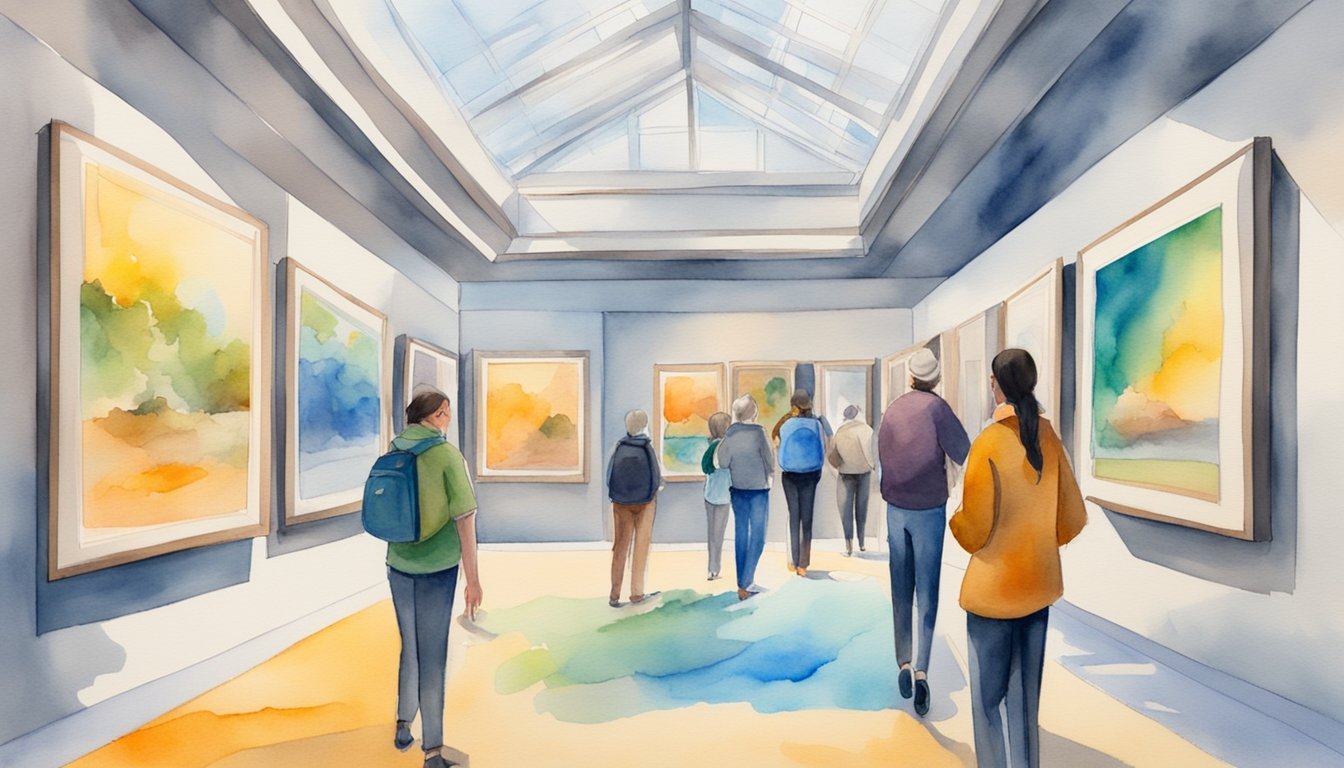
To host a successful virtual art exhibition, you should create content that captures and holds visitors’ attention.
This involves using engaging visuals, interactive elements, and multimedia to make the experience memorable.
Using Videos and GIFs
Videos and GIFs can bring static images to life.
They allow you to showcase the creative process, give virtual tours of a gallery, or highlight details in artworks.
Incorporate short clips where artists talk about their work or time-lapse recordings of a piece being created.
These dynamic elements can be shared on social media to generate buzz and attract a wider audience.
Videos can also provide guided tours, giving insights into each work and the overall exhibit.
GIFs, being shorter, can act as teasers or focus on specific parts of an artwork.
Platforms like Instagram, Twitter, and Facebook are excellent for sharing these quick, eye-catching pieces.
Incorporating Audio Elements
Audio can significantly enhance the virtual exhibition experience.
Consider adding background music that complements the theme of your exhibition.
Alternatively, provide audio guides where the artist explains the meaning behind their work or shares the inspiration for different pieces.
These personal touches help create a deeper connection between the audience and the art.
Using audio elements can also highlight important details that might be overlooked in text descriptions.
For example, include interviews with the artists or narrations that guide visitors through the exhibit.
This makes the exhibition more immersive and engaging, encouraging visitors to spend more time exploring.
Augmented Reality Features
Augmented Reality (AR) can transform a virtual art exhibition into an interactive experience.
With AR, visitors can place digital artworks in their own space using phones or tablets.
This gives a sense of scale and context that traditional online views lack.
Incorporating AR can make your exhibition stand out and offer a unique, memorable experience.
You can also create AR filters or effects for social media platforms, allowing visitors to interact with the art in fun and creative ways.
Interactive features like these encourage audience participation and can help your exhibition reach a broader audience.
Marketing Your Online Art Exhibition

To make your virtual art exhibition a hit, you need strong marketing tactics.
Use social media, targeted email campaigns, and generate press exposure to reach a wider audience and increase engagement.
Social Media Strategies
Promote your exhibition on platforms like Instagram, Facebook, and Twitter.
Share behind-the-scenes content, artist interviews, and sneak peeks of the artwork.
Use hashtags like #VirtualArtShow and #OnlineExhibition to increase visibility.
Interact with your followers by responding to comments and hosting Q&A sessions.
Consider running a live or pre-recorded session of a virtual open studio on your social media.
Collaborate with influencers in the art world to expand your reach.
Email Marketing Campaigns
Build an email list of art enthusiasts and collectors.
Send out newsletters with updates about the upcoming exhibition, including dates and featured artists.
Offer exclusive invites to virtual previews or one-on-one online consultations.
Include enticing visuals of the artwork and artist stories in your emails.
Provide links to your virtual gallery and encourage recipients to share the exhibition with their networks.
Utilize a compelling subject line to increase open rates, and use clear calls to action.
Generating Press Exposure
Create a compelling press release detailing your virtual art exhibition, highlighting unique aspects of the event like the use of AR or VR.
Send the press release to art magazines, blogs, and local media outlets.
Offer media outlets exclusive interviews with the artists and personalized previews of the exhibition.
Pitch story ideas that tie your exhibition to current art trends or cultural events.
Use high-quality images and engaging narratives to capture their interest.
To boost engagement, invite journalists and bloggers to attend and review the exhibition.
Feature any generated press on your website and social media channels to extend your reach even further.
Leveraging Analytics to Understand Your Audience
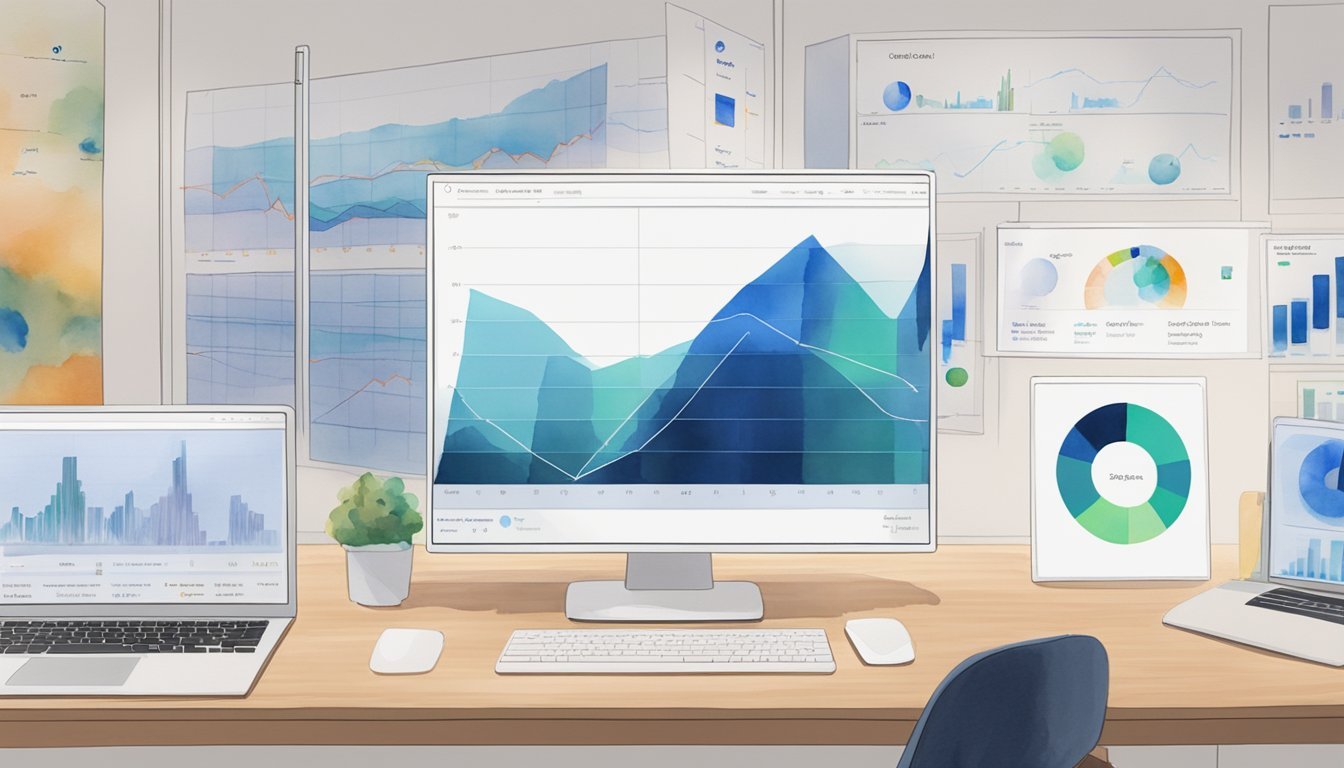
Using analytics for your virtual art exhibition can help you understand your audience, improve their experience, and boost your sales.
Tracking visitor engagement and analyzing data are essential to creating a successful and engaging online exhibit.
Tracking Visitor Engagement
Visitor engagement is a key metric for your virtual exhibition.
You can monitor how much time visitors spend on your site, which artworks they linger on the longest, and what interactive features they use most often.
Tracking these behaviors helps you see what grabs your audience’s attention.
Platforms like Google Analytics can provide insights into your visitors’ behavior.
Knowing your audience’s favorite pieces or pages helps you focus your future efforts on similar content.
This data can be instrumental in tailoring your exhibitions to your audience’s interests.
Additionally, by monitoring clicks on artist information pages and downloads of exhibition brochures, you can gauge interest in supplementary content.
This information helps you offer more of what your audience loves.
Using Data to Improve Experience
Data from your virtual exhibitions is invaluable for improving the overall visitor experience.
If certain features or artworks receive a lot of attention, you can highlight these aspects more prominently.
Also, if you notice some areas have low engagement, you can investigate why and make necessary adjustments.
For example, if visitors aren’t spending much time on certain artworks, consider adding more interactive elements like videos or detailed descriptions.
Analytics can also show you where visitors drop off in the virtual tour, helping you identify potential problem areas.
Feedback tools and surveys are another way to gather data on the visitor experience.
Direct feedback combined with analytic data provides a comprehensive understanding of your audience’s preferences and pain points, allowing you to fine-tune your exhibitions effectively.
Understanding Sales Trends
Analyzing sales data from your virtual art exhibitions can reveal important trends.
Look at which artworks sell the most, peak times for sales, and which marketing channels drive the most purchases.
This information helps you strategize future sales efforts more effectively.
Using revenue-boosting strategies in virtual exhibitions can significantly impact your sales.
For instance, if Instagram is driving traffic to your exhibit, invest more in Instagram ads.
Understanding your sales trends allows you to optimize your marketing efforts.
Return on Investment (ROI) insights from analytics give you a clear picture of which parts of your strategy are successful.
Adjust your approach based on what’s working to maximize your sales potential.
By leveraging analytics, tracking visitor engagement, and understanding sales trends, you can enhance both the experience for your audience and the performance of your virtual art exhibitions.
Maximizing Visitor Interaction
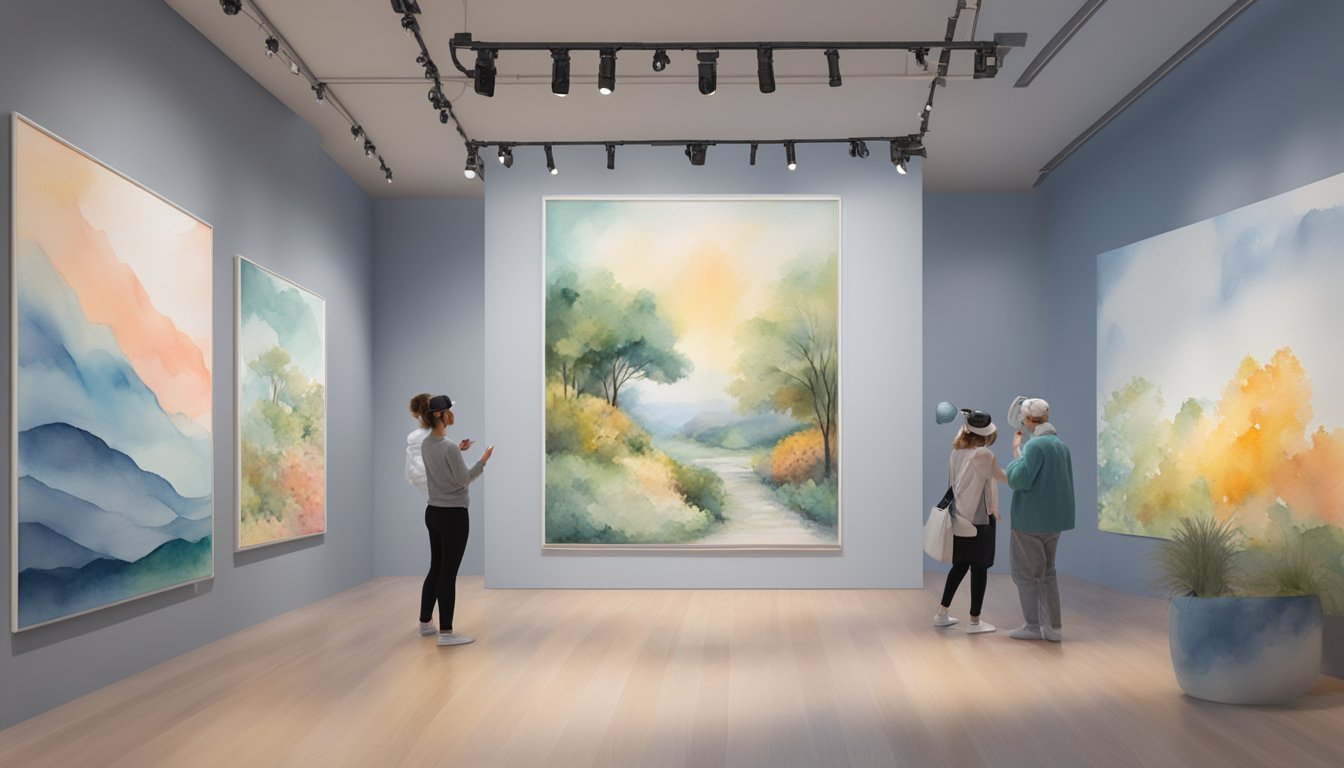
To increase visitor engagement during your virtual art exhibition, focus on creating interactive exhibit booths, hosting live webinar sessions, and providing direct purchase options.
These strategies will keep your audience interested and encourage active participation.
Interactive Exhibit Booths
Interactive exhibit booths are crucial for making your virtual art exhibition engaging.
You can set up booths where visitors can click to learn more about the artwork, view artist interviews, or participate in interactive quizzes or scavenger hunts.
This not only keeps the visitor engaged but also makes the experience memorable.
Using virtual event platforms, you can design user-friendly navigation to help visitors explore different sections easily.
Consider features like virtual tours, where users can “walk” through the exhibition, interacting with artwork descriptions and multimedia elements.
Interactive elements can also include augmented reality options, allowing the viewer to see the artwork in different settings.
Incorporate live chat options to enable conversations between visitors and artists, providing a more personal experience.
Live Webinar Sessions
Hosting live webinar sessions is another great way to enhance interaction.
Webinars can feature discussions with artists, live art demonstrations, and Q&A sessions with curators.
These sessions create a sense of real-time connection, making the virtual event feel more immersive.
Promote webinars in advance to ensure good attendance.
Make them accessible in different time zones to reach a broader audience.
During the webinar, use live polls and interactive Q&A sections to keep visitors engaged.
You can also invite guest speakers who specialize in art history or criticism to provide additional context to the exhibitions.
Offering recordings of these sessions can help those who missed the live events catch up later.
Direct Purchase Options
Providing direct purchase options allows visitors to buy artwork seamlessly during the exhibition.
This can be done by integrating e-commerce features within the virtual event platform.
Clearly visible “Buy Now” buttons next to artworks make it easy for visitors to make purchases on impulse.
Offer multiple payment options to cater to a wide range of buyers.
Ensure the purchasing process is secure and user-friendly, with clear instructions on how to proceed.
Discounts or special offers can also be highlighted to entice potential buyers.
Having a downloadable catalog with pricing and artist details can assist visitors in making informed decisions, enhancing their overall experience and satisfaction.
Extending the Reach to a Global Audience

Hosting a virtual art exhibition offers unique opportunities to connect with art enthusiasts and collectors worldwide.
By employing targeted strategies, you can make your exhibition accessible and appealing globally.
Targeting International Art Collectors
To attract international art collectors, utilize platforms designed for global reach.
Platforms like online art marketplaces allow you to showcase your art to a wide audience.
Next, build relationships with international collectors by participating in forums and groups.
Share insights and engage with potential buyers to build your reputation.
Use targeted marketing campaigns on social media platforms.
Ads in multiple languages can attract collectors from different regions.
Highlight your exhibition’s unique aspects to stand out and appeal to diverse tastes.
Translating Content for Inclusivity
Translating your exhibition materials is essential to reach a global audience.
Offer descriptions, artist statements, and promotional content in multiple languages.
This effort can significantly enhance accessibility and engagement.
Invest in quality translation services rather than machine translations to ensure accuracy.
Make sure cultural nuances are taken into account to prevent misunderstandings.
Provide multilingual support during live virtual events.
This can include live translations or subtitles to allow non-native speakers to follow along easily, making your exhibition more inclusive.
Cultural Considerations
Understanding cultural preferences can enhance your global outreach.
Research the art preferences of different cultures and highlight works that resonate with various audiences.
Be mindful of cultural sensitivities in your presentation.
What might be acceptable in one culture could be offensive in another.
Tailor your messaging and visuals accordingly to avoid any unintentional mistakes.
Highlight international artists or themes that may appeal to different cultures.
This approach not only diversifies your exhibition but also attracts a more varied audience, increasing your potential reach and engagement.
Optimizing for Sales and Lead Generation
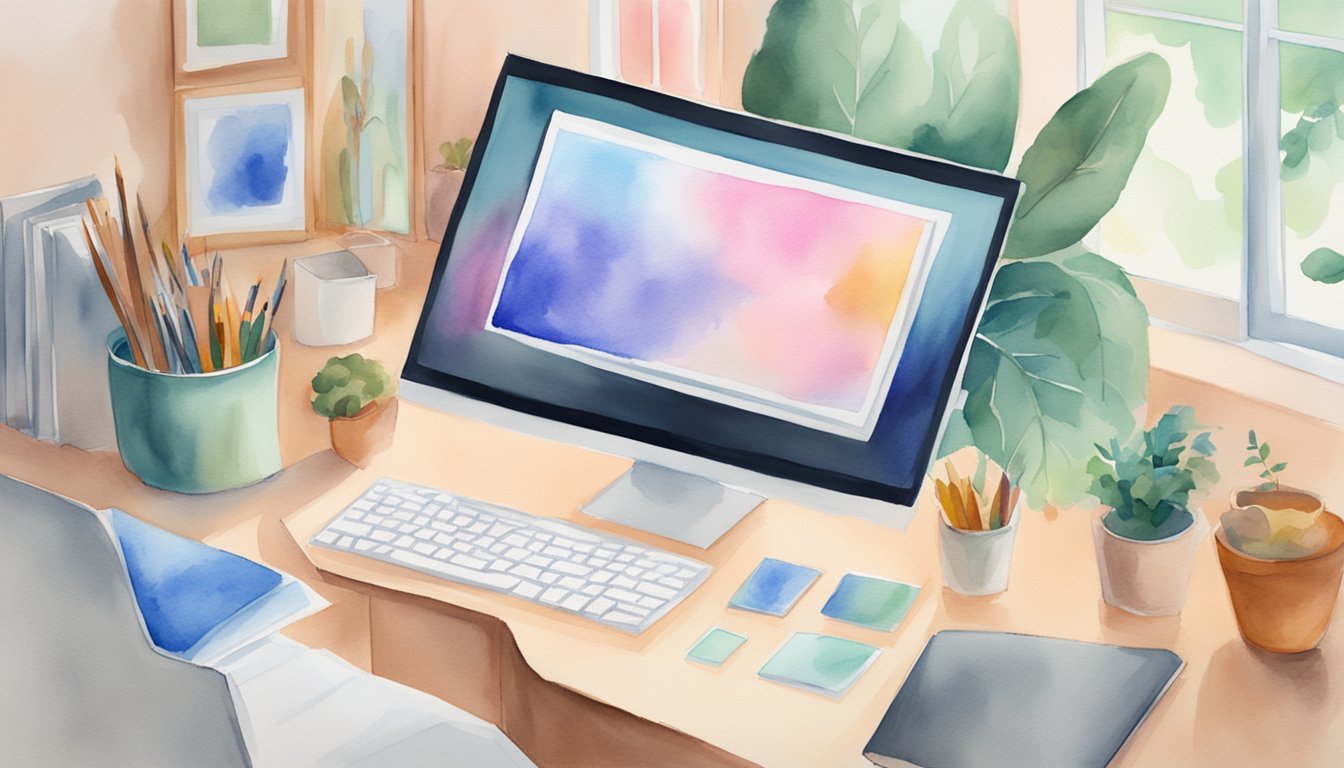
To make your virtual art exhibition a side hustle that generates both sales and valuable leads, focus on making the buying process smooth and building strong relationships with potential collectors.
Creating Seamless Sales Channels
Make it easy for visitors to buy art directly.
Set up clear, conspicuous buy links for each piece.
Include detailed descriptions and prices.
Use virtual gallery software that supports immediate purchase options.
Offer multiple payment methods like credit cards, PayPal, and other reliable platforms.
Also, emailing PDF brochures with clickable buy links can boost sales.
Ensure swift and secure transactions by partnering with trusted e-commerce services.
Providing discounts or special offers to early buyers can generate more leads.
Use limited-time offers to create urgency and encourage quicker purchases.
Social media platforms can also be used to announce promotions and drive traffic to the exhibition.
Fostering Relationships with Collectors
Focus on engaging your audience by providing meaningful interactions.
Host live Q&A sessions with artists to create a personal connection.
Utilize chat features or virtual meet-and-greet events to discuss artworks.
Build robust email lists by inviting visitors to sign up for updates and exclusive previews.
Send personalized follow-up emails to express gratitude for their interest or purchase.
Regular newsletters can keep past and potential collectors informed about upcoming events and new artworks.
Using platforms like LinkedIn can help in reaching out to professional collectors.
Additionally, consider creating VIP access events for loyal collectors, which can deepen relationships and encourage repeat purchases.
These efforts not only drive immediate sales but can turn visitors into long-term patrons.
Building Your Reputation Through Virtual Exhibitions

Establishing yourself as a credible artist involves showcasing your unique style and communicating your vision.
Crafting a strong curatorial statement and highlighting your distinctive aesthetics can boost your reputation.
Crafting a Compelling Curatorial Statement
A curatorial statement helps you explain the ideas behind your art.
This statement builds credibility and lets viewers connect with your work on a deeper level.
When writing it, keep it clear and focused.
Describe your inspirations and the themes you explore.
Avoid jargon and complex language, as this can distance your audience.
Instead, aim for a conversational tone that feels inviting and genuine.
Providing insights into your creative process and the stories behind your pieces can make your exhibition memorable.
This personal touch not only enhances your branding but also makes you more relatable as an artist.
Highlighting Your Unique Aesthetic
Your unique aesthetic is the signature style that sets you apart from others.
Showcasing this consistency across different pieces can help build your reputation in the art world.
Use a variety of multimedia platforms to emphasize your artistic flair.
Incorporate tools like augmented reality (AR) or virtual reality (VR) to create immersive experiences.
This allows viewers to engage with your art in innovative ways, enhancing the overall experience.
Make sure your online presence is consistent.
Your website, social media profiles, and virtual exhibitions should all reflect your unique aesthetic.
Consistency strengthens your brand and assures potential buyers and collaborators of your credibility.
Employing these strategies can significantly impact how others perceive and remember your work, making your virtual exhibitions a successful side hustle.
Post-Exhibition Strategies
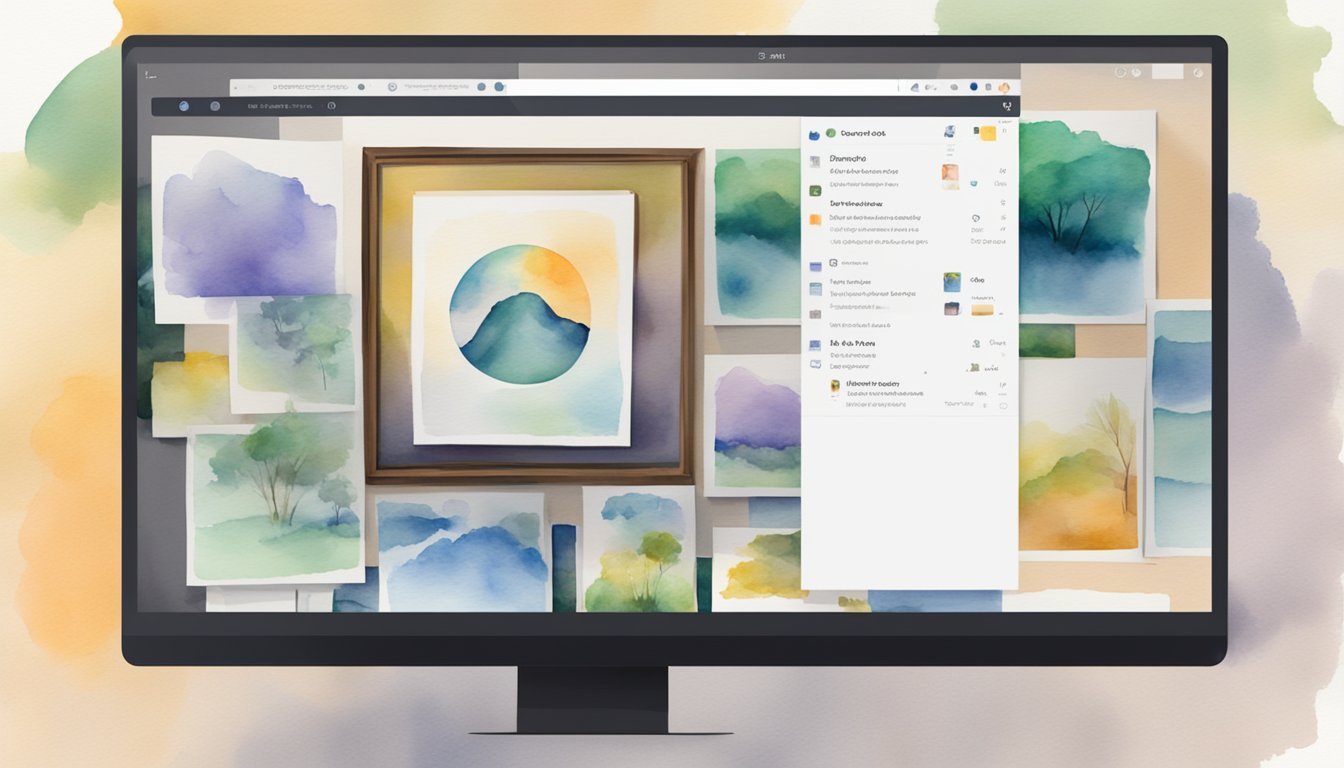
After your virtual art exhibition ends, it’s important to maintain momentum by engaging with your audience, collecting useful feedback, and planning for future events.
You should aim to keep people interested and ensure they remember your work favorably.
Gathering Feedback
Gathering feedback from your attendees is crucial.
It helps you understand their experience and see what worked well or could be improved.
Use surveys and emails to ask specific questions about their likes and dislikes.
Consider using a simple online survey tool to make it easy for people to reply.
Ask about the virtual event platform’s ease of use, the quality of displayed artwork, and the overall engagement.
Encourage detailed responses that can provide valuable insights.
Make sure to promptly respond to any issues or suggestions, showing that you value their opinions and are committed to improving.
This can significantly enhance your reputation and encourage repeat visits.
Continued Engagement After the Show
Don’t just vanish after your event ends.
Continued engagement with your audience keeps their interest alive.
Share updates about your work, future projects, or behind-the-scenes looks on your social media and email newsletters.
Offer exclusive content to keep your audience hooked, such as virtual studio tours or sneak peeks of upcoming exhibitions.
Host Q&A sessions or live discussions to keep the dialogue going.
Implementing these strategies ensures your followers stay invested in your journey, building a loyal community and enhancing your artistic profile consistently.
Preparing for the Next Virtual Event
Preparing for your next event starts immediately after the current one ends.
Review the feedback you’ve gathered to shape and refine your future exhibitions.
Analyze what worked well and where there were hitches.
Look at the performance of your virtual event platform.
Did it handle the traffic well? Were there any technical glitches that need addressing? Ensure your customer support team is aware of frequent issues so they can provide better assistance next time.
Start marketing early.
Build anticipation by updating your audience about your progress and offering snippets of what to expect.
This helps maintain a buzz around your events and draws in a growing crowd each time you host.
Frequently Asked Questions
Setting up a virtual art exhibition can be a great side hustle.
You need to choose the right platform, plan, promote, and handle technical details to make it successful.
What are some popular platforms for hosting virtual art exhibitions?
There are several well-known platforms to consider. ArtPlacer supports various file types and 3D objects. SpotMe is great for inclusion and accessibility. Dreamcast offers engaging tools and diverse formats.
How can I create a virtual art gallery without breaking the bank?
Start with free or low-cost platforms.
Some options let you use basic features without spending too much.
You can also learn to design simple 3D spaces using affordable or free software.
What steps should I follow to promote my online art exhibition?
Use social media to reach your audience.
Share behind-the-scenes content, teasers, and live updates about your event.
Collaborate with influencers and art communities to spread the word.
Can I set up a virtual exhibition on my own, and if so, how?
Yes, you can do it.
Choose a platform, upload your artworks, and design the gallery layout.
Add descriptions and set up navigation tools.
You might need a bit of tech knowledge, but many platforms offer user-friendly interfaces.
Are there free templates available to design 3D virtual art galleries?
Yes, many platforms offer free templates.
These templates help you create professional-looking galleries without needing extensive design skills.
Look for platforms that provide customizable templates.
What are the main features to look for when choosing a virtual exhibition platform?
Check for easy navigation, file compatibility, and customization options.
Look for tools that support 3D objects, high-quality images, and videos.
Features like visitor analytics and interactive elements can also enhance your exhibition.






